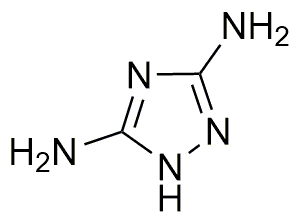3,5-Diamino-1,2,4-triazole is widely utilized in research focused on:
- Agricultural Chemicals: This compound serves as a potent plant growth regulator, enhancing crop yields and improving resistance to environmental stressors.
- Pharmaceutical Development: It is explored for its potential in synthesizing new pharmaceuticals, particularly in the development of anti-cancer agents due to its ability to inhibit specific enzymes.
- Analytical Chemistry: Used as a reagent in various analytical methods, it helps in the detection and quantification of metals and other compounds, making it valuable in environmental monitoring.
- Polymer Science: This chemical acts as a cross-linking agent in polymer formulations, improving the mechanical properties and thermal stability of materials.
- Biochemical Research: It is applied in studies related to enzyme activity, particularly in understanding metabolic pathways, which can lead to advancements in biotechnology.
General Information
Properties
Safety and Regulations
Applications
3,5-Diamino-1,2,4-triazole is widely utilized in research focused on:
- Agricultural Chemicals: This compound serves as a potent plant growth regulator, enhancing crop yields and improving resistance to environmental stressors.
- Pharmaceutical Development: It is explored for its potential in synthesizing new pharmaceuticals, particularly in the development of anti-cancer agents due to its ability to inhibit specific enzymes.
- Analytical Chemistry: Used as a reagent in various analytical methods, it helps in the detection and quantification of metals and other compounds, making it valuable in environmental monitoring.
- Polymer Science: This chemical acts as a cross-linking agent in polymer formulations, improving the mechanical properties and thermal stability of materials.
- Biochemical Research: It is applied in studies related to enzyme activity, particularly in understanding metabolic pathways, which can lead to advancements in biotechnology.
Documents
Safety Data Sheets (SDS)
The SDS provides comprehensive safety information on handling, storage, and disposal of the product.
Product Specification (PS)
The PS provides a comprehensive breakdown of the product’s properties, including chemical composition, physical state, purity, and storage requirements. It also details acceptable quality ranges and the product's intended applications.
Certificates of Analysis (COA)
Search for Certificates of Analysis (COA) by entering the products Lot Number. Lot and Batch Numbers can be found on a product’s label following the words ‘Lot’ or ‘Batch’.
Numéro de catalogue
Numéro de lot/série
Certificates Of Origin (COO)
This COO confirms the country where the product was manufactured, and also details the materials and components used in it and whether it is derived from natural, synthetic, or other specific sources. This certificate may be required for customs, trade, and regulatory compliance.
Numéro de catalogue
Numéro de lot/série
Safety Data Sheets (SDS)
The SDS provides comprehensive safety information on handling, storage, and disposal of the product.
DownloadProduct Specification (PS)
The PS provides a comprehensive breakdown of the product’s properties, including chemical composition, physical state, purity, and storage requirements. It also details acceptable quality ranges and the product's intended applications.
DownloadCertificates of Analysis (COA)
Search for Certificates of Analysis (COA) by entering the products Lot Number. Lot and Batch Numbers can be found on a product’s label following the words ‘Lot’ or ‘Batch’.
Numéro de catalogue
Numéro de lot/série
Certificates Of Origin (COO)
This COO confirms the country where the product was manufactured, and also details the materials and components used in it and whether it is derived from natural, synthetic, or other specific sources. This certificate may be required for customs, trade, and regulatory compliance.


